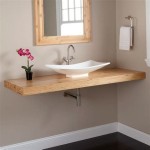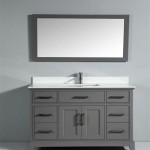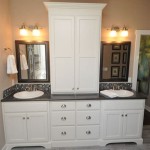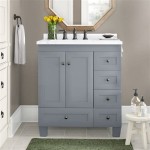Can I Paint My Bathroom Vanity?
A bathroom vanity can be a significant investment, and its appearance can greatly influence the overall aesthetic of the space. While replacing a vanity might seem like the only option for a refresh, painting your existing vanity can be a budget-friendly and transformative solution.
Before embarking on this project, it's essential to consider several factors that will impact the success of your endeavor and ensure you achieve the desired outcome. This article will explore the key considerations when deciding whether painting your bathroom vanity is a viable option and provide guidance on navigating the process effectively.
Assessing the Condition of Your Vanity
The first step is to evaluate the current state of your vanity. This assessment will determine if painting is a suitable solution. Examine the vanity for the following:
- Structural Damage: Look for any cracks, loose joints, or warping that may compromise the stability of the vanity. If significant structural issues exist, painting may not be the best course of action as a more comprehensive repair or replacement might be necessary.
- Surface Quality: Carefully inspect the surface for scratches, chips, or peeling veneer. These imperfections can impact the final appearance of the painted finish, requiring additional sanding and preparation to achieve a smooth and even outcome.
- Previous Paint: If the vanity has been painted previously, determine the type of paint used. If the existing paint is oil-based, a primer specifically designed for oil-based paints may be needed to ensure proper adhesion of the new coat. Additionally, the age and condition of the existing paint will determine whether it needs to be stripped before painting.
By thoroughly assessing the condition of your vanity, you can determine if painting is a feasible option. If the vanity is in good structural condition, and the surface is free from major imperfections, painting can be a viable and cost-effective way to revitalize the vanity and enhance the bathroom's appearance.
Selecting the Right Paint
Choosing the appropriate paint is crucial for a successful bathroom vanity painting project. The bathroom environment presents unique challenges due to the presence of moisture and humidity. Consider these factors when selecting your paint:
- Moisture Resistance: Select a paint specifically formulated for high-moisture areas. These paints contain additives that provide resistance to mold, mildew, and water damage, ensuring the longevity and durability of the painted finish.
- Durability: Bathroom vanities are subject to frequent use and cleaning. Choose a paint known for its durability, abrasion resistance, and ability to withstand repeated cleaning without chipping or peeling.
- Finish: The finish of the paint will determine the overall look and feel of the vanity. Consider matte, semi-gloss, or high-gloss finishes based on your desired aesthetic. Matte finishes are known for their subtle elegance, while semi-gloss and high-gloss finishes offer greater durability and ease of cleaning.
By carefully selecting the right paint, you can ensure that your bathroom vanity is protected from moisture damage, withstands daily use, and maintains its fresh appearance for years to come.
Preparing the Vanity for Painting
Adequate preparation is essential for a smooth and successful painting process. This step will ensure that the paint adheres properly and provides a long-lasting finish. Follow these steps to prepare your vanity:
- Cleaning: Thoroughly clean the vanity with a mild detergent and warm water to remove any dirt, grime, or grease. Allow the surface to dry completely before proceeding.
- Sanding: Sand the surface of the vanity to create a smooth, even surface for the paint to adhere to. Start with coarse-grit sandpaper and gradually work your way to finer-grit sandpaper for a smooth finish.
- Priming: Apply a primer to create an even, consistent surface for the paint. Choose a primer specifically designed for the type of surface you are painting. Always allow the primer to dry completely before applying the paint.
- Taping: Mask off areas that you do not wish to paint, such as hardware, countertops, or surrounding walls. This will help to prevent paint from getting into unintended areas and ensure a clean and precise finished product.
By taking the time to properly prepare your vanity, you can ensure that the paint adheres properly and provides a smooth, lasting finish. This will enhance the appearance of your vanity and contribute to a successful painting project.
.jpg?strip=all)
Painting A Bathroom Vanity Again Dream Green Diy
.jpg?strip=all)
Painting A Bathroom Vanity Again Dream Green Diy

How To Paint Bathroom Cabinets Without Sanding 8 Vital Steps Grace In My Space

How To Paint A Bathroom Vanity Helpful Tips Calypso In The Country

How To Paint Bathroom Vanity Cabinets Tutorial Benjamin Moore

Bathroom Vanity Makeover With Chalk Paint Decor Adventures

Chalk Painted Bathroom Vanity Makeover Our Storied Home

Paint Bathroom Vanity Countertop Sink So Easy A Piece Of Rainbow

21 Beautiful Painted Bathroom Cabinet Ideas
.jpg?strip=all)
Painting A Bathroom Vanity Again Dream Green Diy







